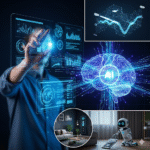
7 Amazing AI Tools Nobody Is Talking About (But Will Blow Up Soon)
The world is buzzing with AI, from ChatGPT’s conversational prowess to Midjourney’s stunning image generation. These mainstream tools have undeniably transformed how we work and create. However, beneath the surface of popular discourse, a new wave of highly specialized and incredibly powerful AI tools is quietly developing. These are the AI tools nobody is talking about yet, but they are poised to revolutionize industries, streamline workflows, and enhance daily life in ways we’re just beginning to imagine.
Get ready to dive deep into the next generation of artificial intelligence. This blog post will unveil seven cutting-edge AI tools nobody is talking about right now, but which are destined for explosive growth and widespread adoption in the very near future. Prepare to get ahead of the curve!
The AI Landscape: Beyond the Hype
While tools like Large Language Models (LLMs) and generative art AI have captured public imagination, the true power of AI often lies in its niche applications. Developers are leveraging breakthroughs in machine learning, neural networks, and data processing to create highly specialized solutions for complex problems. These are the AI tools nobody is talking about because they’re often deep within research labs, startup incubators, or specialized industry verticals. Yet, their potential to disrupt and innovate is immense.
The evolution of AI isn’t just about making existing tasks easier; it’s about enabling entirely new capabilities that were previously impossible. The AI tools nobody is talking about today will be the household names of tomorrow.
7 Amazing AI Tools Nobody Is Talking About (But Will Blow Up Soon)
Here are seven incredible AI tools nobody is talking about right now, but which are on the verge of widespread recognition and adoption.
1. Hyper-Personalized Adaptive Learning Platforms
Forget generic online courses. The next wave of educational AI is about tailoring learning experiences to an unprecedented degree. These are a crucial category of AI tools nobody is talking about but will redefine education.
- What they do: These platforms use AI to analyze a student’s learning style, pace, strengths, weaknesses, and even emotional state in real-time. They then adapt the curriculum, teaching methods, and content delivery to maximize comprehension and retention for that individual.
- How they work: Leveraging advanced machine learning, these tools create a dynamic learning path, identifying concepts a student struggles with and providing targeted resources, interactive exercises, and even AI tutors that explain things in multiple ways.
- Impact: This will democratize highly effective, personalized education, making it accessible to millions. Imagine a student in a remote village in Karnataka receiving an education perfectly tailored to their needs, just like having a personal tutor.
2. AI-Powered “Thought-to-Text” Interfaces
This sounds like science fiction, but it’s becoming a reality. These are perhaps the most mind-blowing of the AI tools nobody is talking about.
- What they do: Researchers are developing interfaces that can interpret brain signals (e.g., via non-invasive EEG or more advanced neural implants) and translate them directly into text, code, or commands.
- How they work: AI algorithms learn to recognize patterns in brain activity associated with specific thoughts, intentions, or even imagined speech, converting these into actionable digital output.
- Impact: This could revolutionize accessibility for individuals with severe motor impairments, allow for incredibly fast data input for professionals, and fundamentally change human-computer interaction by making it entirely thought-driven.

3. Predictive Healthcare Diagnostics for Early Detection
Beyond current diagnostic tools, AI is moving into proactively predicting health issues before symptoms even appear. These are vital AI tools nobody is talking about that could save countless lives.
- What they do: These AI systems analyze vast amounts of health data – genetic predispositions, lifestyle factors, environmental exposures, and real-time biometric data from wearables – to identify patterns indicative of future disease onset (e.g., certain cancers, cardiovascular diseases, neurological disorders).
- How they work: Machine learning models are trained on massive datasets of patient histories, outcomes, and research, allowing them to spot subtle markers that human doctors might miss.
- Impact: This will enable truly preventative medicine, allowing for early intervention that drastically improves treatment outcomes and saves lives. Imagine an AI detecting early signs of a condition years before it becomes symptomatic.
4. AI for Hyper-Realistic 3D Asset Generation
The demand for high-quality 3D models and environments for gaming, metaverse, film, and industrial design is immense. These are incredibly powerful AI tools nobody is talking about in the creative space.
- What they do: These AI models can generate incredibly detailed, texture-rich, and animation-ready 3D assets from simple text prompts, 2D images, or even rough sketches, dramatically reducing the time and cost of 3D content creation.
- How they work: Leveraging generative adversarial networks (GANs) and neural radiance fields (NeRFs), the AI can create complex geometries and realistic textures, often at speeds and quality levels unmatched by human artists.
- Impact: This will democratize 3D content creation, accelerate development in gaming and virtual reality, and enable rapid prototyping in design and architecture, making photorealistic virtual worlds more accessible.
5. Autonomous Legal Research and Document Drafting Tools
The legal profession is notoriously detail-oriented and time-consuming. AI is quietly automating much of this work. These are impactful AI tools nobody is talking about in the legal sector.
- What they do: These AI platforms can conduct exhaustive legal research, identify relevant precedents, analyze case law, and even draft complex legal documents (contracts, briefs, wills) with high accuracy, far faster than human lawyers.
- How they work: Trained on vast legal databases, AI uses NLP to understand legal language, identify key clauses, and generate contextually appropriate text, cross-referencing against millions of documents.
- Impact: This will significantly reduce legal costs, make legal services more accessible, and free up lawyers to focus on strategy, negotiation, and client interaction, rather than repetitive research.
6. Emotion-AI for Enhanced Human-Computer Interaction
Understanding human emotion is key to truly intelligent interfaces. These are subtle but game-changing AI tools nobody is talking about that will make tech more intuitive.
- What they do: Emotion-AI uses computer vision, natural language processing, and voice analysis to detect and interpret human emotions (e.g., frustration, joy, confusion, stress) in real-time.
- How they work: Machine learning models are trained on datasets of facial expressions, vocal inflections, and textual sentiment to accurately infer emotional states.
- Impact: This will lead to more empathetic customer service agents (both human and AI), adaptive educational tools that respond to student frustration, and smart devices that adjust their behavior based on your mood, making technology feel far more human-aware.
7. AI-Driven Personal Supply Chain & Inventory Managers
Ever wished your pantry restocked itself? AI is making it possible. These are practical AI tools nobody is talking about for daily home management.
- What they do: These AI systems connect to your smart home appliances, purchase history, and even smart sensors (e.g., in a fridge or pantry) to track consumption, predict needs, and automatically order groceries, household items, or even manage personal subscriptions.
- How they work: AI analyzes consumption patterns, expiration dates, deals from various retailers, and your personal preferences to create optimized shopping lists and execute orders automatically.
- Impact: This will eliminate mental load, reduce waste (by preventing over-purchasing or spoilage), and save time and money by finding the best deals and ensuring you never run out of essentials.
Why These AI Tools Nobody Is Talking About Will Dominate
The reason these AI tools nobody is talking about are set to blow up is multifaceted:
- Solving Real Problems: They address genuine pain points in specific industries or daily life.
- Niche Expertise: Unlike general-purpose AIs, they excel in their specialized domains.
- Efficiency & Cost Savings: They offer significant improvements in productivity and reductions in operational costs.
- Ethical Deployment: Many are being developed with a strong focus on ethical guidelines and user privacy.
The Impact in Bengaluru and Globally
In a tech hub like Bengaluru, the adoption of these AI tools nobody is talking about will be particularly rapid. Startups and established companies alike are constantly seeking innovations to gain a competitive edge. Local businesses could leverage these tools for hyper-personalized customer experiences, optimizing logistics, or enhancing internal R&D. Globally, these tools will contribute to a more efficient, intelligent, and interconnected world across every sector.
Conclusion: The Quiet Revolution of AI
While the spotlight often shines on the most talked-about AI applications, a quiet revolution is brewing beneath the surface. The AI tools nobody is talking about right now represent the future of intelligent automation and personalized assistance. From transforming education and healthcare to revolutionizing creative work and daily chores, these innovations are set to fundamentally change our relationship with technology. Staying informed about these emerging tools isn’t just about curiosity; it’s about preparing for a future where AI empowers us in unprecedented ways. Get ready to witness their explosive growth!
rest of the season.
reddit.com




